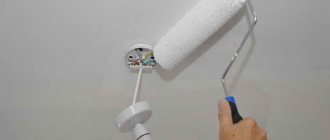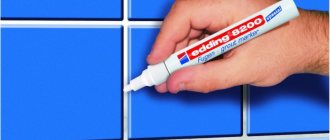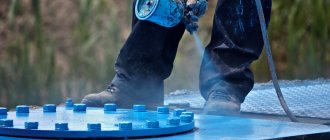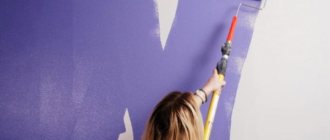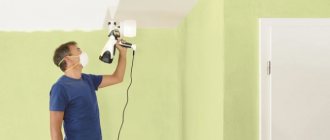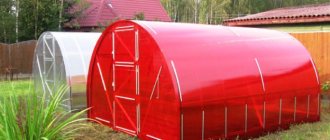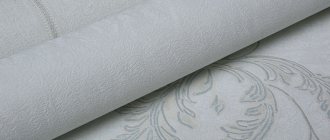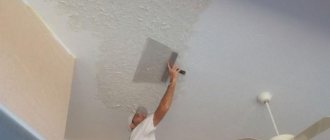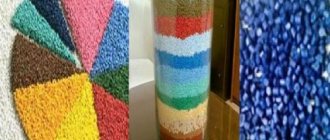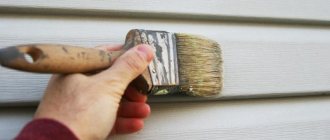Developed in the mid-70s. of the last century, alkyd enamel PF-115 meets modern requirements in terms of technical characteristics. The material is suitable for painting metal or wooden structures located indoors and outdoors. Additional advantages are the coating's resistance to ultraviolet light and good hiding power.
PF-115 enamel, developed in the 70s of the last century, is well suited for painting wooden structures.
GOST and certificate of conformity
Oil paint PF-115 is produced in accordance with GOST 6465, developed by the USSR Ministry of Chemical Industry. The standard was put into effect in mid-1977 by a resolution of the State Committee for Standards. Over the subsequent years, the documentation has undergone several editions; the adjustments made did not affect the standard number.
Each manufacturer receives a certificate with a limited validity period. The document confirms the compliance of paints and varnishes with the requirements.
Some companies issue certificates in accordance with Russian GOST R 51691-2008, which describes the general requirements for paints and enamels (on any basis). Regardless of the standard, the document indicates the name and address of the manufacturer and a list of test reports. The additional field lists the timing of inspection control (to verify compliance of production conditions and product characteristics with requirements).
Manual tinting
Acrylic enamel tinting can be done at home. The process includes several stages.
What will you need?
For tinting paint you will need the following materials and tools:
- White base. The quantity is calculated taking into account the surface area. Add 10% to the consumption indicated in the instructions. Take into account the need to apply several layers.
- Colors. The number of packages depends on the saturation of the desired color.
- Capacity. The paint is mixed in a basin or bucket.
- Mixer. The tool can be replaced with a drill with the required attachment.
- A small container for creating a test composition.
- Color dispensing tool. A pipette or syringe will do. Some dye bottles are equipped with dispensers.
Creating a Probe
This stage is necessary to calculate the required amount of color. The probe is created like this:
- A small amount of enamel is poured into the tray. Using a pipette, measure the required volume of color.
- The values are recorded and the composition is mixed until a uniform tone is obtained.
- The colorant is added until the desired color is obtained. The necessary information is recorded after each step.
The sample is prepared in the room where the renovation is being done. It must be taken into account that artificial and natural lighting reflects shades differently. The finished composition is applied to cardboard or plywood, after which it is inspected from different sides.
Getting the right shade
Add 4/5 of the pigment used for the sample to 1 liter of base paint. If 100 ml of enamel was mixed with 5 drops of dye, 40 drops are taken per 1 liter of base. To reduce brightness, the volume of color is reduced. After adding the pigment, the composition is thoroughly mixed with a construction mixer or drill. The nozzle should rotate at low speed.
It is not recommended to stir the paint using improvised means. The coating acquires defects in the form of stripes and spots. The composition is applied to cardboard and the resulting tone is assessed. The color can be made brighter by adding a small amount of color.
Composition of pentaphthalic paint
The material includes:
- rutile type titanium dioxide TiO2 suspension;
- additional fillers to change fluidity;
- pigments that determine color (for example, yellow or black);
- driers that accelerate polymerization;
- alkyd varnish (solvent).
The percentage of components depends on the shade of the paint material. The ingredients are mixed at the factory in a special tank, and then the liquid is packaged with the batch number indicated. When purchasing several cans, you must select containers from the same series, otherwise you will need to mix materials in a tank with an increased volume. When applying paint produced in different work shifts, shade deviations are possible (allowed by the standard and not a sign of defects).
The pigments that make up the enamel determine its color.
Enamel tinting or how important it is to get the color right
Wood products have been used by people for many centuries both as a building material and as a basis for the production of furniture and home improvement. Even with the advent of metal and various other building materials, wood remains a favorite raw material in many areas of construction.
And thanks to the emergence of modern processing materials, for example in the form of paint and varnish processing products, which can significantly extend the life of a particular wooden item, as well as improve and improve its appearance, this option has become simply irreplaceable, especially in the manufacture of furniture.
Paint and varnish materials are special compositions that are a mixture of several elements. They are applied to objects in liquid form, and subsequently they dry and form a strong, reliable film. It is able to protect a wooden product from natural influences, and also gives it an unusual color, appearance and texture.
Of all the varieties of paints and varnishes, enamels are especially popular, and to be precise, enamel tinting.
At its core, this is the same paint, but it has certain differences. For example, in composition, a similar product is a suspension of pigments and fillers in a solution of an artificial or synthetic polymer. The film formed after the enamel dries is much stronger than the ink film and has a shine.
Technical characteristics of enamel
In accordance with the standard, paints of the PF-115 series have 2 quality gradations (highest and first grade). OKP codes are used to separate materials. For example, gray enamel of the highest category has the identifier 231222053900, and the first is assigned the index 231222043903. Please note that paints in red, cherry and black colors are supplied only in accordance with the standards of the first grade.
To dilute materials to working viscosity, solvent or nefras is used (reagents must meet the requirements of GOST 1928 and 3134, respectively).
It is allowed to use pure turpentine or a mixture with solvent or white spirit in a mass ratio of 1:1. If the layer is to be applied in an electrostatic field, then the enamel is diluted with RE-4V or RE-3V solvent.
After polymerization, the paint coating has a uniform surface without defects and cracks; the standard allows for the appearance of slight shagreen. The gloss factor calculated using a photoelectric measuring device is 50 and 60% (for first and highest grades, respectively). Viscosity ranges from 60 to 120 units (depending on the shade and category). Measurements are taken at an ambient temperature of +20°C by feeding through a sprayer with a nozzle with a diameter of 4 mm.
The percentage of non-volatile substances depends on the type of material and shade, ranging from 49 to 70%, particle size is 10-25 microns. When diluted to a consistency suitable for a spray gun, up to 30% of the solvent must be introduced into the enamel. The polymerization time depends on the color; for interior work it is better not to use enamels in cherry and red shades, which require 48 hours to harden. Other materials of the PF-115 series dry within a day. The elasticity of the resulting film when bending does not exceed 1 mm (regardless of the type).
To assess the resistance of the layer to impact loads, a pendulum ball device is used. According to the requirements, the coating should not be deformed when struck from a distance of 400-500 mm. Under a layer of water at an ambient temperature of +20°C, premium grade paint does not deteriorate for 10 hours (materials of the first category do not withstand 120 minutes).
The standard requires resistance to the influence of a 0.5% cleaning solution for 15 minutes; transformer oils should not destroy the layer when applied for 24 hours.
In industrial conditions, it is allowed to dry the paint in a chamber with air heated to +105°...+110°C for 60 minutes. The standard regulates the primary colors of PF-115, but manufacturers can produce materials with individual tinting (for example, based on control samples provided by the customer). To determine the shade, methods regulated by the GOST 29319 standard are used.
There are two types of enamel tinting:
scientific It is mainly used for painting small volumes of product surfaces. In addition, it is also applicable in such works as renovation of premises, etc. The main advantage of the manual method is the ability to create colors according to your own taste and color perception. In addition, it does not require large financial costs and can be carried out indoors. However, manual tinting of enamel also has its drawbacks. And first of all, it is still impossible to obtain a high-quality color range, and mixing occurs unevenly.
Tinting using special equipment (automatic). This process is possible through the use of appropriate technology and software. This way you get a wide range of color palettes in large production volumes. The enamel is tinted quickly and efficiently; all the necessary components are mixed in special equipment. You just need to select the desired color or shade, set the program, and a modern device will do the rest for you.
It must be said that a special substance (color) is produced in bulk form and only then added to the enamel. The production of the required composition is based on a white product. Note that for light tones a solution with a certain white pigment is used, and for dark tones a different concentration of this element is required. Therefore, to obtain high-quality results, enamel tinting should be entrusted to professionals.
The color spectrum is shown in the tables below:
Using our equipment you can accurately select the color of paint (enamel) for your product. We produce colored enamels to order.
Relying on our extensive experience, we have selected advanced technologies and the experience of paint application professionals from several companies.
For all technical issues, you can contact our specialists, who will try to advise you as fully as possible. In order to find out the price of varnish, just call our multi-line phone in Moscow: +7 (495) 984-50-50. By sending a message to our email address
We ask you to leave a note in the subject of the letter indicating that you have received technical advice, indicating your telephone number and contact information. After processing the question, a technologist will contact you.
Scope of application of enamel
Scope of material application:
- painting of building structures made of wood;
- application to walls of premises subject to regular wet cleaning;
- protection of metal products operated in various meteorological conditions.
Enamel is used to paint structures made of wood.
The versatility of enamel allows you to work indoors. For example, PF-115 is used for painting steel pipes and radiators of heating systems; the material does not peel off or turn yellow when exposed to elevated temperatures. When using, the low abrasion resistance of the paint layer should be taken into account. PF-115 is not intended for application to floor coverings or structures exposed to external abrasive influences.
PF series enamels are not designed for use at elevated temperatures. For example, do not apply the material to metal roofs or fences that are exposed to direct sunlight. The paint retains its strength and adheres to the base when heated to +60°C. Temperature stability does not depend on the number of layers and type of primer applied to the products.
Benefits of use
Main advantages of enamel:
- low cost;
- resistance to external weather influences;
- the ability to operate painted products in conditions of high humidity;
- increased service life of the paintwork;
- low specific consumption (subject to preliminary priming of the surface);
- high adhesion to the base, cleared of loose fragments;
- resistance to temperature deformation and cracking.
Disadvantages of PF-115
Disadvantages of the material noted by the masters:
- long polymerization period (at least 24 hours);
- applying the next layer is possible only after the previous one has hardened;
- increased toxicity and fire hazard of vapors and the paint itself;
- unpleasant odor when solvent evaporates;
- limited temperature stability;
- low abrasive strength;
- excessive density of the layer, which after polymerization does not allow water vapor to pass through.
An unpleasant odor during solvent evaporation is one of the disadvantages of using PF-115 enamel.
Painting scheme with PF-115 enamel
Primer for metal: use “GF-0119”, “VL-05”, “GF-021”, “VL-023” (always with the number 0 at the beginning).
You can paint without primer, but then the enamel must be diluted with a solvent (sometimes up to 50%).
A rusty surface can be treated not only with PF-115 (in two layers), but also with “Unicor K” - a water-dispersion primer paint with the addition of auxiliary substances and a synthetic polymer (one layer is enough).
PF-115 paint is suitable for treating oiled wood - apply no more than three layers. Wood treated with drying oil will be covered with a protective film and will save enamel consumption.
Three layers are applied to plaster, brickwork, concrete coating, old, worn or in need of restoration surfaces.
After applying the solution, you need to wait at least a day; in some cases, removable parts can be dried at a temperature of no more than 110°C (for one hour).
What should the enamel be like?
Enamel that meets the standards should not have a strong odor. The formation of an insoluble film on the surface is not allowed. If the paint is partially dry, it is recommended to purchase a new can. It should be remembered that it is impossible to dissolve frozen fragments; when applied with a brush or roller, pieces of film will remain on the surface.
When assessing quality, you should take into account how long it takes for the applied test smear to dry. The drying time for PF-115 to touch-free, regardless of brand and shade, should not exceed 8-10 hours.
High-quality enamel has a uniform structure; during long-term storage, components can be separated by specific gravity. The paint has the standard smell of an organic solvent; there are no spots of a different color or clots on the surface. After stirring the material with a mixer or hand tool, the paint should flow evenly from the surface of the tool.
What it is?
Color for acrylic paint is a special concentrated dye, which is added in a certain volume to the color mixture to obtain a particular shade. Subsequently, the paint is thoroughly mixed with the pigment and applied to the required surface. The shade of the mixture can be adjusted manually according to the recommendations given in the instructions.
Using the correct proportion, you can obtain the desired intensity of a tone of a specific color , and you can also mix several shades of colors, adding them to one acrylic mixture.
It is very important to follow the instructions when adding it to acrylic paint, since any deviations from the proportions may further degrade the quality of the acrylic itself.
Learn more about use
Before starting use, you should familiarize yourself with:
- safety regulations;
- a list of solvents and enamel dilution technology;
- mass consumption of material per 1 m² of surface (to calculate the need);
- a list of tools and devices necessary to perform the work;
- rules for applying and choosing a paint scheme;
- standards for selecting the type of paint depending on the characteristics of surfaces;
- storage conditions of the material.
Safety precautions
Basic rules when using paint:
- Since the material contains organic solvents, the enamels of the PF-115 series belong to the category of fire hazardous and toxic substances. For example, turpentine vapors ignite already at +34°C, and spontaneous combustion occurs when heated to +300°C. When applying with a brush or spray gun, the use of open flame sources is not allowed.
- Emitted vapors of solvents penetrate the human body through the mucous membranes of the eyes, skin and respiratory tract. Work must be performed in ventilated areas using protective clothing and a respirator. To ensure air exchange, it is allowed to use artificial ventilation (for example, an electric hood). Indoors, it is necessary to open windows and doors; the risk of street dust or fluff from plants sticking to painted surfaces should be taken into account.
- The components contained in the material must not enter the sewerage system, onto the ground or into water bodies. The remaining paint must be disposed of in metal packaging as hazardous waste. If the container is cleared of traces of enamel, then disposal of the products together with household waste is allowed.
- If spilled paint ignites, it is necessary to use sand or a felt made of non-flammable fabric material to extinguish. It is permissible to use foam or carbon dioxide fire extinguishers or sprinkler extinguishing systems with a spray of tap water.
It is strictly forbidden to use enamel near an open flame source.
Dilution of pentaphthalic enamel
Manufacturers supply the paint ready for application, but during long-term storage or before refilling the sprayer, the material must be diluted. Thick enamel clogs the nozzle channels and does not provide uniform coverage of surfaces.
The volatility of the solvent has a slight effect on the hardening time (deviation within 2-4 hours). For PF-115, petroleum-based liquids (for example, solvent or white spirit) or special materials RE-4V or RE-3V are used.
Sequence of actions for breeding:
- Open the paint container and mix the material by hand or with an electric mixer.
- Add solvent; if the volume of the factory container is insufficient, then the components must be poured into a container with increased capacity.
- Stir the solution until a homogeneous mass is obtained. Pigment clumps are not allowed, since lumps clog the spray nozzle and reduce the quality of the coating when using a brush or roller. It is recommended to use an electric drill with a mixer. With a manual technique, clots may remain in the structure of the material. Select the rotation speed of the device experimentally; the tool should not splash paint over the edge of the container.
Paint consumption depending on shade
When using PF-115, you should take into account the floating consumption when painting, depending on the shade. The reason for the different results is the uneven size of the filler fraction. Material costs are influenced by the application method and surface characteristics. For example, untreated wood, brick or porous concrete will absorb some of the enamel, requiring a repeat pass with a brush or spray.
Required Tools
To apply the paint layer the following can be used:
- brush with synthetic or natural bristles - the width is selected depending on the size of the surfaces;
- felt roller with a standard handle or with an extension rod for painting walls at a great distance from the ground;
- pneumatic spray gun with electric compressor and pressure regulator;
- baths with liquid paint and a manipulator that immerses parts in the solution (used in industrial settings).
When processing surfaces, a separate paint reservoir may be required (for example, to ensure uniform wetting of the roller). To prepare liquid enamel before filling it into the spray tank, you will need a container with a volume of 1-2 liters. When painting indoor surfaces, it is necessary to use a protective material for the floor or interior items (for example, plastic film or old wallpaper).
To apply the paint layer, it is recommended to use a brush with synthetic or natural bristles.
Rules for working with paint
When applying the coating you must:
- Inspect surfaces that are free from oil stains or traces of moisture. Please note that painting is carried out at a relative air humidity of less than 80%. It is not allowed to use the material in cold weather (minimum ambient temperature +5°C). If the requirements are violated, the polymerization time increases and adhesion deteriorates.
- If there is dirt on the surface or peeling of the old paint coating, it is necessary to clean it (for example, using an abrasive tool). Wooden products should be impregnated with antiseptic primer to prevent rotting and mold formation. If work is carried out indoors, then use diluted enamel as a primer (solvent share no more than 10%). Clean metal structures with sandpaper or steel brush from traces of corrosion, wash with a degreasing compound and apply a layer of primer.
Painting schemes
Since PF-115 enamel is universal, application of the material in any direction is allowed. The master needs to control the uniformity of the layer on the surface and avoid the formation of clots. It should be noted that liquid paint can flow down vertical or inclined walls during the hardening process, so you should control the volume of applied enamel.
Selection of enamel depending on the surface
If the base has a dark shade, then several layers of enamel will be required. Otherwise, after polymerization, unpainted areas may remain on the surface.
A second coat requires 10-15% less enamel, but before applying it is necessary to wait 24 hours for the primary coating to polymerize.
When using a spray gun, some of the material is sprayed into the air, which leads to increased paint consumption, but provides a smooth surface without foreign inclusions (for example, brush lint).
Storage conditions
Packaged in sealed containers, the paint can withstand transportation and storage in rooms with negative air temperatures. Frost resistance is not regulated by the standard, but the material should not be cooled to -20°C or lower. Storage near heat sources is not allowed, since at elevated temperatures some of the solvent evaporates with the formation of clots or a dense film on the surface. Manufacturers allow paint to be stored for 24 months from the date of packaging, subject to climatic conditions.
Color does not dissolve in paint
A customer bought a liter jar of white enamel “Oreol” from me. I decided to tint it myself - I bought another 100 ml bottle of the PalIzh brand (New House - Izhevsk) pistachio color. I poured the color into the paint, closed the jar and shook it for half an hour (!) When I opened it, I saw that the paint was still white, and small pieces of the color were floating in it. If you take a drop of paint and smear it on the tin with your finger, the color mixes with the paint and you get a normal pistachio color.
How can I get the colors to mix now?
And a separate question, how does a color containing polyhydric alcohol (glycol) mix with alkyd paint? After all, polyhydric alcohols mix easily with water, but not at all with alkyd and oil varnishes?
are you asking us? I would try this: you bend the wire and screw it into a drill. you put it in the jar and twist it.
Explain to me better why you need alkyd enamel when you can paint it with a water dispersion of acrylic? what does she give?
When tinting, the most difficult and important thing is the compatibility of tinting pastes and base paints. Industrial tinting pastes are usually intended for one type of material. Universal ones, used in consumer goods, and usually made by dispersing in ethylene glycol with the addition of surfactants, dyes, pigments, etc., can only be used for materials that contain the same solvents. Glycol compositions slow drying (especially alkyds) and increase the water sensitivity of water-based paints. The limited compatibility of surface-treated glycols with fatty alkyds, aggravated by the presence of heteropolar pigments in the base (hydrophilic polar inorganic white pigment titanium dioxide) and in the tinting paste (hydrophobic non-polar organic phthalocyanine blue and green and organic yellow, used for pistachio color), leads to delamination, separation of the white base and color paste into separate incompatible phases. Elimination of this phenomenon is achieved by smoothing, leveling, neutralizing charges using mechanical dispersion (the most effective method), i.e. rubbing with friction, what you get when you smear your finger on tin) or adding superdispersants such as Solsperse, although they are not always help with simple mixing. You can also use NICs or dispersants and try it in a small sample. Sometimes an additional selection of solvents or intermediate varnishes helps. But it’s hard to say in absentia. I’m not familiar with Izhevsk pastes. It’s a pity that you don’t have a simple small mechanical attritor in your store or base (after all, you offer paint and varnish materials to customers), they would quickly solve the buyer’s problem, and they would also charge money for it. This is a very effective, inexpensive and easy to use device. It combines all the incompatibility.
There are no instruments at my outlet, much less a tinting machine.
So how can the issue be resolved in this case? Perhaps time will help? Someone told me that the color, which did not want to mix in any way, after 2-3 weeks of the paint standing in the jar, still mixed as it should.
The problem is the pigment. Aleid mixes well with glycol colors. Until recently, all universal pigments for tinting systems were based on diethylene glycol. It’s just that in this PalIzh, obviously, the water is generally swollen.
Water you say. Yes, apparently it is. Let’s take a color from another brand, “Collection of Cozy Colors.” Also Izhevsk “Izhsintez”. We read the composition on the bottle: “Pigments, dispersant, dispersion stabilizer, wetting agents, polyhydric alcohol, defoamer, preservative in container, water.” Presented as a universal tinting paste.
There are also universal TEX colors. Perhaps they are better? I haven't tried it. If they get a good response here, I'll try to sell them.
The question is, why don’t manufacturers widely release colors for alkyd and oil-based materials. After all, colors are produced specifically for water-dispersion ones.
The question remains what to do with this ill-fated tinted paint. How to mix colors?
If the color is not mixed immediately, then there is little chance that this will happen. I'm not an advisor here. TEX colors will be better. As for colors for alkyds. I have seen them more than once. It’s just that water-based paints are used more often, and demand creates supply.
kai wrote: If the color is not mixed right away, then there is little chance that this will happen.
That's for sure. One chance in a thousand. And all due to the fact that glycol “universal” colors do not combine well with alkyds on FAT varnishes, which Oreol apparently belongs to. In general, water-soluble polyhydric alcohols and fat are difficult to combine even with the addition of surfactants, unlike alkyds on medium-fat varnishes and modified alkyds. Buy colors for alkyds and oils. Manufacturers meet at exhibitions, although there is no information at hand, but you can search. Still, I recommend using an attritor. Make it yourself. If you're interested, I'll tell you how, it's inexpensive and convenient.
I picked up several bottles of TEX in different colors from the warehouse. And I instantly felt the difference:
TEX colors mix perfectly with any alkyd paints
I took one bottle, standing upright, on top there was an almost transparent liquid - apparently glycol. This liquid mixes quite well with fatty alkyd varnishes, forming a persistent, slightly cloudy mixture.
Compatibility with other dyes
PF enamels are compatible with putty of the GF, KF, MS and PF series. It is not allowed to apply paint to NC, PE and CV materials due to low adhesion and chemical incompatibility. The enamel swells and moves away from the base. Mixing PF-115 with paints and varnishes based on acrylic, melamine or polyurethane is not allowed.
PF-115 enamel is compatible with the GF series primer.
Acrylic paint tinting
Some colorants come in a base color of white. The answer to the question of whether it is possible to add color to acrylic paint is positive. By correctly mixing white enamel with pigment, any shade can be obtained. Tinting paint can be difficult, so take some recommendations into account when working.
Color is necessary when you need to create some special shade.
Cost of enamel
The average price of the material starts from 50 rubles. per 1 kg (for wholesale quantities weighing more than 1000 kg). A jar weighing 2.5 kg (manufactured by Tex) will cost a retail buyer 770-800 rubles. A tank weighing 0.9 kg has a cost in the range of 240-180 rubles. There are budget manufacturers (for example the Formula brand) offering 1.9-kilogram cans at a price of 390 rubles. Some building materials stores hold sales, in which case the buyer can save up to 10-15% of the starting price.
What should you consider when tinting yourself?
When creating a shade yourself, consider the following points:
- Acrylic enamels used to renovate rooms have varying degrees of whiteness. The higher this value, the richer the tone.
- Paints and varnishes have markings that reflect their intended purpose. Materials marked “for ceilings” should not be used for painting walls. The working qualities of coloring agents differ. The choice of color depends on the type of white base.
- On a larger area the paint looks richer. Walls with openings have a darker shade. The textured surface looks different.
- A shiny coating reflects light well, so it is not recommended to give the paint a too bright tone.
Popular manufacturers
Paints of the PF-115 series are produced by several companies. The materials differ in density and proportion of dry components, the number of shades depends on the manufacturer. Packages weighing up to 50 kg are offered, which allows the client to paint a large area in a single color. To reduce material consumption, it is recommended to clean the surfaces from contamination and cover them with a layer of primer. No manufacturer offers modified PF-115 enamel suitable for floor treatment (it is recommended to use wear-resistant paint PF-266 or analogues).
“Lakra”
Lakra brand enamel is supplied in cans weighing from 1 to 50 kg. Please note that the manufacturer uses containers with different parameters for different shades. The material contains crushed micronized marble, which improves the characteristics of the paint layer after polymerization. The production program includes materials of 20 colors (glossy type), white enamel with a matte effect is provided.
The manufacturer “Lakra” uses containers with different parameters for different shades.
Optimum
The Optimum brand belongs to the Tex company; the enamel is supplied in metal cans weighing from 0.9 to 2.7 kg. The manufacturer offers white paint in containers weighing 10 kg; upon special orders, the materials are packaged in packaging weighing 20 kg. After applying the paints (a total of 18 shades are produced), a glossy surface is formed; matte white enamel is present in the product line. According to the plant, the layer retains its integrity for 5 years (subject to compliance with the application technology).
Characteristics:
- consumption for single-layer application – 1 kg is enough for 7-11 m²;
- share of dry components – 74%;
- type of solvent – white spirit;
- Touch-free polymerization time is at least 5 hours.
“Bio”
Paints from the manufacturer “BioKhim” (St. Petersburg) are supplied in containers weighing from 1.2 kg. The enamel is applied manually or using a pneumatic sprayer. The amount of solvent depends on the painting technology; the polymerization time is set at 24 hours. Another manufacturer of materials with the prefix “Bio” is Doktor Farbe. A colloidal solution of silver particles has been introduced into the enamel, which makes it possible to increase the antimicrobial effect of the paint and varnish coating.
The material from Doktor Farbe (the brand belongs to the KVIL company) is suitable for use in children's and medical institutions. Before application, you should clarify how to dilute the paint with antibacterial additives. Since the additional components are based on an inorganic base, the use of white spirit or solvent is allowed.
"Prestige"
Enamel from the Prestige company is supplied in metal cans and buckets weighing from 0.4 to 50 kg. The manufacturer offers 33 basic shades; it is possible to tint the desired color by introducing 10% pigment into the white paint. The product is supplied ready for application, but before starting work the material should be mixed (dilution with solvent or white spirit is allowed, the proportion of the solution is no more than 5%).
Technical specifications:
- consumption – from 0.1 to 0.18 kg/m²;
- coating service life – up to 7 years;
- application temperature – from +5 to +35°С;
- Drying time – 24 hours (regardless of shade).
The enamel from the manufacturer “Prestige” has a drying time of 24 hours (regardless of the shade).
“Hacienda”
The Fazenda brand belongs to the Tex company. The company offers enamels of the PF-115 series (12 basic shades, including chocolate and lime) in metal containers weighing up to 20 kg. Since the materials are intended for budget repairs, the durability of the coating is reduced to 3 years. Enamels are designed for painting metal and wooden structures, but are not suitable for floors due to insufficient wear resistance. The manufacturer guarantees the stability of the paint characteristics for 24 months, provided that the storage rules and sealed containers are followed.
Material characteristics:
- consumption rate for 1 layer – from 0.06 to 0.17 kg/m²;
- density – from 1.35 to 1.45 kg/l;
- share of dry ingredients – 75%;
- solvent brand – white spirit;
- polymerization time from dust (at +20°C) – from 6 to 8 hours.
The manufacturer indicates that to increase the service life to 3 years for outdoor use, it is necessary to coat metal structures with anti-corrosion primer GF-021. Wooden parts can be treated with putty, which reduces the absorption coefficient. After polymerization, the paint layer becomes moisture resistant and is not destroyed by denatured alcohol, white spirit or turpentine.
“Tex”
PF-115 enamel from the Tex company, intended for work on metal and wood, is supplied in cans with a sealed lid weighing from 0.9 to 24 kg. The manufacturer ships the material ready for application, dust accumulation stops after 5-7 hours, the service life of the glossy paintwork reaches up to 6 years. 11 primary colors are offered; the client can obtain additional shades on his own (the proportion is calculated using a special calculator).
Main characteristics:
- consumption per 1 m2 - from 0.09 to 0.14 kg (depending on the application method and the absorbency of the base);
- dry residue share – 74%;
- density – from 1.2 to 1.4 kg/l (depending on the volume of solvent).
General step-by-step instructions for using PF-115 paints
The first thing to do is to remove dust, dirt or rust from the parts. Wait for the surface to dry or dry it with a heat gun.
If you are going to paint wooden surfaces, treat the wood with an antiseptic (and the metal with primer).
Mix the enamel with solvent, if necessary.
Choosing a primer for metal
Alkyd enamel PF-115 according to GOST is ideal for painting structures made of non-ferrous metal (aluminum, steel, brass or copper).
Before applying the first layer of mortar, pipes, benches, fences or swings are coated with a special primer for metal.
The primer enhances the adhesion of paint to a metal surface, slows down the process of peeling and rust on parts, increases the service life of the entire structure and reduces consumption.
People who don't prime at all often blame the quality of the enamel when surfaces show rust spots or chips.
But most often the reason for rapid deterioration is the lack of primer under the layer.
It is more profitable to buy primer (there is a quick-drying one) than to redo all the work and spend twice as much money.
The primer is available not only for non-ferrous metal, but also for ferrous metal (cast iron), iron coatings and various alloys.
You can buy primer for coatings (converters) that already show signs of destruction - just apply the solution to the damaged surface.
Types of primer mixtures:
- Alkyd – quick-drying, durable, protects the metal from the inside.
- Based on orthophosphoric acid – removes rust and restores damage.
- Acrylic – levels, enhances the adhesion of surfaces of various liquid compositions.
- Passivating – for external application, moisture-resistant, protects against rust.
- Epoxy – moisture resistant, suitable for painting cars.
- The primer is available in the form of a powder mixture (you need to dilute it according to the instructions indicated on the package).
Before purchasing, check the composition on the bag (based on the amount of consumption per 1 m2 of PF-115, you can calculate how much soil will be needed for the entire area). The mixture must be diluted strictly according to the instructions.
How to paint metal surfaces correctly
After the primer has dried, open the can of enamel (don't forget that the marking should contain the number 0).
Apply the first coat of paint to a clean surface.
Without a primer, you can paint decorative metal parts that are located at home and not outside (you can add white spirit to the solution to thin it).
If PF-115 paint does not have special additives (corrosion converters), you cannot paint untreated rusty parts; be sure to wipe them with a degreaser.
Drying oil for wood processing
It is better if the wood is treated with drying oil - foam, which contains a lot of vegetable oils that have undergone all oxidative processes and pressure at high temperatures. Drying oil is viscous and is suitable for mixing varnishes, paints and enamel solutions.
The solution is used for protective impregnation before applying the main paint and as an independent coating.
Types of drying oil:
- Natural – without artificial solvents, based on flaxseed, sometimes sunflower or hemp oil (contains a drier).
- Semi-natural – sunflower oil mixed with white spirit or other solvents.
- Combined - from oils that have dried (thickly grated paints are made).
- Synthetic - from coal, oil, waste synthetic rubber. Used to create dark shades. It has a pungent odor, is cheap due to its low quality and is used only for external treatment.
To paint wood or prepare a paste for mixing paints and varnishes, a high-quality impregnation must be light.
It can only be applied at room temperature. With hemp oil, the solution has a darker shade, and sunflower drying oil takes the longest to dry, and does not always dry out even after 24 hours.
Natural drying oil breathes new life into old wood, returning the brightness and shine of the treated surface.
The only thing is that it is not recommended to lubricate floors with drying oil - the protective film cannot withstand constant pressure.
The combined solution is suitable for treating wood before painting or priming.
How to paint wood
First of all, clean the wood from dust and dirt, then saturate it with drying oil (it is convenient to work with a wide brush with long bristles).
If you decide to disinfect wood with an antiseptic, be careful when choosing products - most of them are only suitable for acrylic-based paints; when mixed with alkyd enamel, the surface may swell after painting.
Don't skimp on the liquid.
The next step is drying.
When the wood dries, paint the surface with enamel at least three times (wood absorbs all liquids well). Use a roller or brush.
After the first layer has dried, it is recommended to sand the surface, then the wood will be smooth, without lint. Apply the next two coats without sanding, but be sure to allow the enamel to dry after each application.
Aerated concrete, plaster, concrete, brickwork
All mineral surfaces are painted without applying primer. Treat the surface with anti-mold products. You can paint the walls only six months after laying (humidity no more than 15%).

